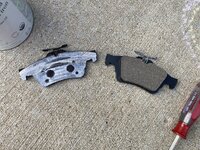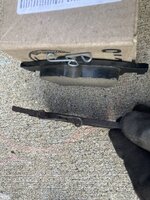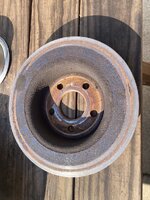2019 Ford Transit Connect 2.0L, only has about 34k miles.
1. Vehicle was making a grinding sound when coming to a complete stop.
2. Discovered the inner brake pads on both the rear driver and passenger side are worn down to nothing. See photos. Photo is comparison of the worn pad vs a new one.
3. The outter rear pads had more thickness than the inner pads.
4. It appears the piston is sticking? It just seems unlikely that the rear piston would be sticking on both the driver and passenger side?
5. I turned the rear driver side piston and it turned back to its home position without much effort. With that being said, I did use one of those brake caliper compression tools, not sure if this tool would hide any type of resistance/ problem with the piston?
6. Could this be caused by something else? Stuck emergency brake?
Any help would be appreciated. Thanks
1. Vehicle was making a grinding sound when coming to a complete stop.
2. Discovered the inner brake pads on both the rear driver and passenger side are worn down to nothing. See photos. Photo is comparison of the worn pad vs a new one.
3. The outter rear pads had more thickness than the inner pads.
4. It appears the piston is sticking? It just seems unlikely that the rear piston would be sticking on both the driver and passenger side?
5. I turned the rear driver side piston and it turned back to its home position without much effort. With that being said, I did use one of those brake caliper compression tools, not sure if this tool would hide any type of resistance/ problem with the piston?
6. Could this be caused by something else? Stuck emergency brake?
Any help would be appreciated. Thanks



